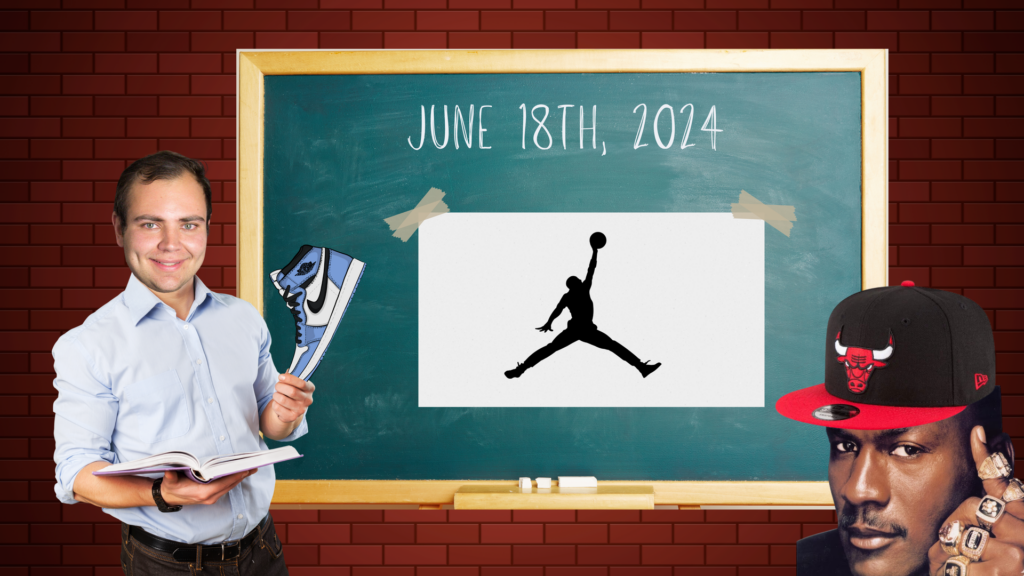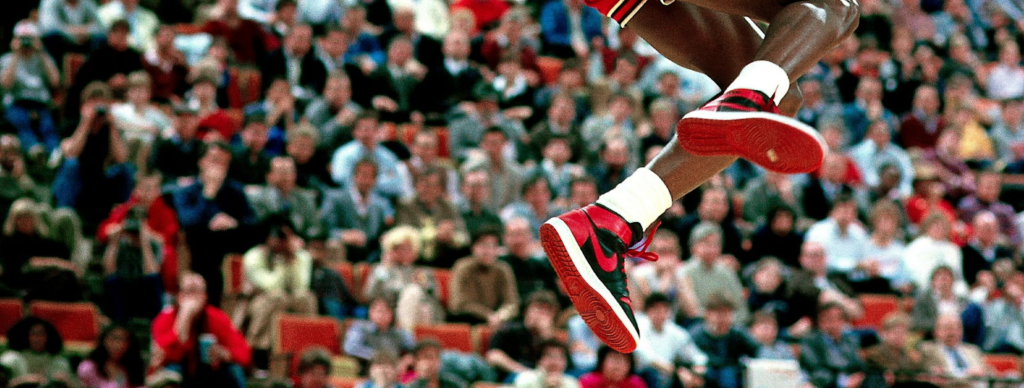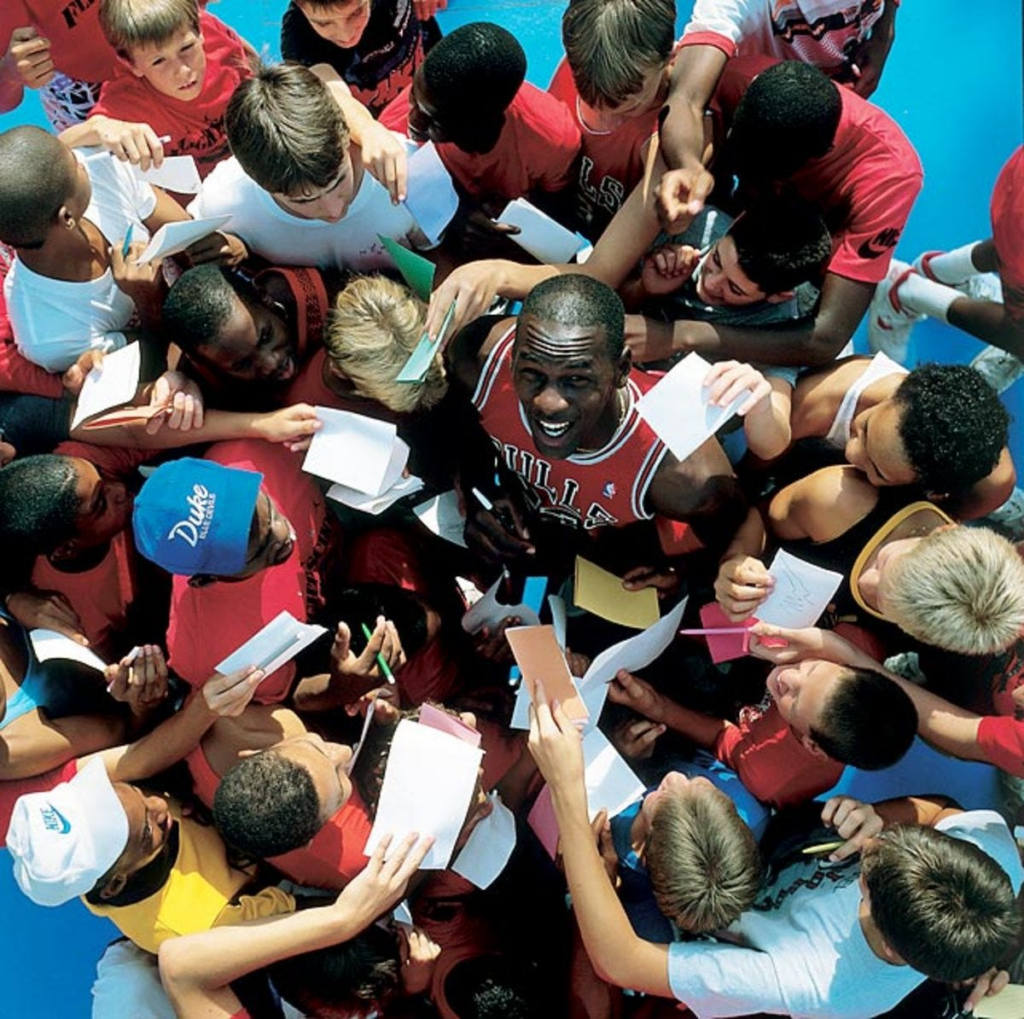Converse ruled the world, inking shoe deals with Magic Johnson, Larry Bird, and Isiah Thomas, three of the biggest names in basketball in the ‘80s.
Adidas had a shoe deal with Kareem Abdul Jabbar and Puma had a deal with Walt Frazier.
There was a Mount Rushmore of shoe brands forming who were dominating the sports world.
And looking up at this Mount Rushmore was this shy little track running shoe company founded in Oregon by a guy named Phil Knight.

The track running shoe company went by the name, Nike. Like the Greek goddess of victory? Yes.
Nobody had heard of this so-called “Nike” brand in the world of basketball. The outside pressure was real, Nike had solidified themselves in the world of running, but other shoe brands were dominating the more lucrative NBA and NFL markets.
The desire to tap into the NBA was mounting for Phil Knight and Nike, they needed to do something.
Their plan? Lose money. (More on that shortly.)

That’s when the 1984 NBA draft came around and this kid from North Carolina was drafted 3rd overall to the Chicago Bulls. Knowing they wouldn’t be in the conversation to sign the 1st and 2nd overall picks of the draft, Nike went straight for 3rd.
The rookie, whose name you might know, was Michael Jordan. A talented basketball player without a doubt, but one that came with a few red flags as far as his potential. Could he shoot with the best of them? No. Did he have great size to compete physically in the NBA? Not quite. But Nike saw something in him.
However, Jordan didn’t see anything in Nike…

The original colorway of the shoes Nike presented Jordan in their negotiations were met with BIG resistance.
At the same time, Jordan was in deep talks with Adidas and Converse, but wasn’t sold either. His complaints were that the two brands just saw Michael as another vessel to sell their existing shoe lines, and Nike took that into account.
In their final meeting, Nike offered Jordan a 5-year $2.5M contract (3x any other brand deal at the time) to release a signature Air Jordan sneaker line. Jordan signed the deal on the first day of his rookie season.

The first signature shoe was a red and black colorway, mimicking that of the Chicago Bulls. And on September 15th Jordan wore the shoes for the first time in a preseason game and was immediately fined $5,000.
The shoes broke the NBA’s protocol which required players to wear shoes that were at least 51% white or black, and could include a minimal team color accent.
Level up your marketing game
Zero BS. Just fun, unfiltered, industry insights with the game-changers behind some of the coolest companies from around the globe.
No spam. Unsubscribe any time.
Jordan’s rookie contract was for $455,000 a year, so if he wore these shoes every game during the season he would have to cough up 90% of his earnings back to the NBA. To make things worse, the NBA banned the shoes altogether.

But Nike saw an opportunity, there was an Elvis shaking his hips chance here with Jordan.
Rebellion, exclusivity, and a common enemy are three of the most effective ways to position your brand, product, and service and this situation had all three AT ONCE.
1️⃣. The NBA was dictating the actions of Jordan and Nike, instigating that urge for rebellion from consumers.
2️⃣. The NBA banned the shoes, lighting that flame of exclusivity.
3️⃣. And the NBA was becoming the bad guy in the eyes of Nike and their customers, aka the common enemy they needed.

Nike recognized this and told Jordan to keep wearing his signature shoes, take the $5,000 fine, and they would pay for it every time.
Anytime Jordan would wear the shoes, he would be fined, the media would cover it, Air Jordans became the hottest topic in the sports world. Cue the “All publicity is good publicity” comments.
Nike then took it to the next level releasing a full blown campaign AGAINST THE NBA.
(Here’s a screenshot from the commercial. 👇)

They weren’t shying away from this squabble. They knew the NBA was ticked off, Nike also knew that this would be their last shot at climbing Mount Rushmore, so they acted accordingly.
In a simple, straightforward shot of MJ dribbling a basketball in the already iconic Air Jordans, Nike’s campaign called out the NBA directly. The commercial read: “On September 15th Nike created a revolutionary basketball shoe, on October 18th the NBA threw them out of the game.”
Nothing from MJ, just shots from Nike to the NBA, with a CTA that says “Fortunately the NBA can’t stop YOU from wearing them.”
The feud between the two brands is captivating, but Nike made sure to be intentional with this push against the much larger brand, the NBA. The campaign subtly leaned into the psychological tendencies they know humans have and Nike knows they’ll be able to use to their advantage.

Have you ever had someone ask you to do a task when you had originally planned to do that task? And after they ask you, you have the urge to no longer do the task? That is our natural human tendency for autonomy in full effect.
The NBA was telling Michael Jordan and consumers that they can’t wear Jordans, immediately tapping into our psychology to react against that and achieve freedom again by doing the very thing we have been told NOT to do (buy and wear Air Jordans).
Also, by highlighting the fact that the NBA banned the shoes, an air of exclusivity comes across the Air Jordans.
To consumers the grass always looks greener on the other side, aka we all want what we can’t have. And if the NBA is telling us we can’t have Air Jordans, then you BEST BELIEVE I’m getting my hands on a pair.

Not to mention the fact that Nike now had a MASSIVE common enemy that they could rally their community against. This sense of a shared distaste for the NBA made Air Jordans more than just shoes, it made them a revolution. Like political groups, it was either you’re on Jordan’s side or the NBA’s side, no in between.
This meant everything for a tiny brand looking to disrupt the behemoths that were Converse and Adidas.
Jordan’s original deal had a clause in it that if they didn’t sell $4M worth of shoes by the 3rd year Nike would void the deal. In the first year alone Nike and Jordan sold $126M worth of shoes and the partnership will go down as one of the greatest collabs of ALL TIME.

In 2023 Jordan Brand did $6.59B in revenue, Michael Jordan earned $330M last year alone from royalties, and Nike DOMINATES the NBA with partnerships with LeBron, Kevin Durant, Giannis Antetokounmpo, and virtually every other upper echelon player.
The path is NEVER clear, Jordan wasn’t supposed to become the greatest player of all time, Nike wasn’t supposed to knock Converse off their throne, but all of that happened thanks to a few calculated risks from the Marketing brains at Nike.
Lesson: Just do it.


